Sustainable Theatre Design
University of Minnesota, Morris
by Lucas Granholm
The University of Minnesota Morris (UMM) is among the leaders in sustainability education on college campuses in the Midwest. Thus, it makes sense that the Theatre Arts program is no different! In the fall of 2016 the Theatre Arts Discipline produced William Shakespeare’s A Midsummer Night's Dream as part of our ongoing commitment to producing sustainable productions.
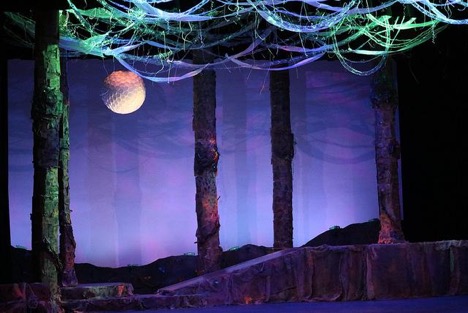
In this production the design team borrowed heavily from the aesthetics of architect Antoni Gaudi and the glam rock-era of David Bowie to develop a general aesthetic to work off of. When designing a theatrical production from recycled materials, the production team must shift their expectations and calendars to a more non-traditional time table. Designers are put in a situation, wherein; the materials scavenged dictate the direction of the design rather than the other way around.
The origins of this production reach back almost a decade. The UMM Theatre Arts and Studio Arts programs have been exploring how to incorporate waste in creative ways. This was started with Professor of Studio Art Jess Larson and Professor of Theatre Arts Ray Schultz and the production of As You Like It in 2010 at UMM. From this point on we have been incorporating recycled items from one point or another in a variety of shows in various capacities, most recently, A Midsummer Night’s Dream, and The Wonderful Wizard of Oz
For the production of A Midsummer Night’s Dream, our ultimate goal was to not alter materials beyond the point of recycling them after the show had closed. Depending upon local guidelines rules of recycling materials vary. Factors such as… materials covered in paints, stains, or contact with oils often times cannot be recycled due to the process of recycling the materials. Our goal was to be able to recycle as much material as possible, to be able to place the end product back into the bins that we originally pulled them out of.
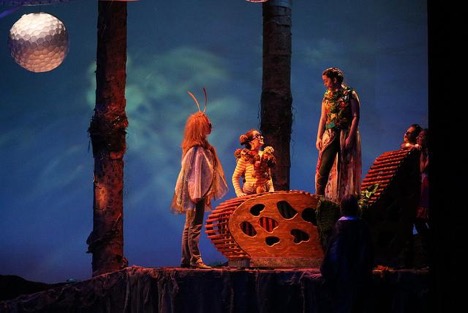
Furthermore, when thinking about strike of a recycled set, one must think ahead of the build, particularly if the goal is to recycle the set properly. As with any strike, the goal is to to move quickly, efficiently and most importantly SAFELY. Due to the nature of the building materials we were using, time had to be taken to strike materials such as staples from the cardboard to avoid injury at the recycling center down the road.
The process of recycling lumber for this type of production starts early in the design process, and is an important discussion to have immediately as it affects a great as to how the set will look. One must make the conscious decision if they want to use reclaimed lumber or use lumber in a responsible and sustainable manner. The use of reclaimed lumber often brings about a variety of design challenges that must be addressed early in the process. Utilizing reclaimed lumber often results in the design team sacrificing a variety of luxuries we are accustomed to such as, height of set pieces, or flying scenic units due to the unknown structural integrity of reclaimed lumber. Furthermore, the most available lumber in our region was shipping pallet lumber. Reclaiming pallet lumber is a time consuming and at times dirty job that one must consider before using. We also found pallet lumber to be flimsy and often half rotten. For this particular production of Midsummer it was decided early in the process that we would not be using reclaimed wood for safety and time constraint reasons. The production team decided that keeping the scenic units as stock as possible would be our safest and greenest solution. To do this the Scenic Designer altered existing stock platforms, or designed scenic elements to standard stock lumber dimensions. This process not only aided in saving money, but also allowed for the re-use of the lumber in future productions.
From a pedagogical perspective, we have found that this process helps our students to grow as designers. The process of “up-cycling” or re-purposing existing materials, allows the designers to think about how to get an end product rather than finding what fits. In other words, the student must think…. How can I bend this? Crush this? Twist this? Etc. To get the end product needed.
A major factor when considering doing a green production is time. We are all familiar with the “golden triangle” of good, cheap, and fast. However, when working with reclaimed materials a design team must budget their time accordingly. Extra time must be taken to alter materials in manners they were not designed for. This is extremely evident in costume design. Wherein the Costume Designer, Jess Larson, weaved materials such as old VHS tape, and old burlap to create the looks needed on stage. Altering these materials takes time, often reverse engineering materials to suit the needs of the production.
Another challenge when designing with reclaimed materials is the unknown. The unknown of how to design a set before you know what materials you can scavenge, beg, borrow, or dumpster dive for. In the case of A Midsummer Night's Dream, the design team knew full well that plastic bottles and cardboard boxes were going to be our best friend in regard to design. 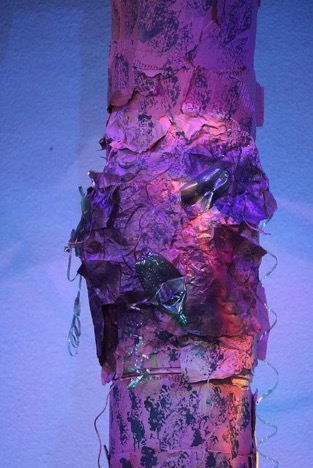 Living in a smaller rural community Amazon boxes are available in abundance as well as burlap. Use of these materials then became a key point for the forest scenes in Midsummer, as their rough natural look paired well with a forest setting.
Living in a smaller rural community Amazon boxes are available in abundance as well as burlap. Use of these materials then became a key point for the forest scenes in Midsummer, as their rough natural look paired well with a forest setting.
We also found that when working with reclaimed materials, the materials diminish faster than standard materials. At this point the design team found it beneficial to create a public drop site in the student center, wherein the campus community could drop off materials that might be needed for the production. We found that creating a drop site, developed strong community interest in the production and expanded ownership of the production to the campus community at large.
Working with recycled materials is an ongoing process in a production, and often is not a linear process. However, it is a far more rewarding a process in design as if forces the design team to problem solve far beyond what is the norm. Furthermore, the process is not cut and dry and like any production is different every time it is done. At UMM we have been finding that audiences respond to sustainable productions in an exceptionally positive manner, and look forward to them far more than an average productions.
If you have any further questions or would like to discuss this further please feel free to contact me as this is a very brief overview of a process that is far deeper than can be written about here!
Luke Granholm is Assistant Professor of Theatre Arts at The University of Minnesota Morris.
Below are production stills of recent green productions- A Midsummer Night's Dream and The Wonderful Wizard of Oz produced by UMM.
****************************
University of Minnesota Morris
Theatre Discipline’s production of
A Midsummer Night’s Dream
By
William Shakespeare
Director: Ray Schultz
Scenic Design: Lucas Granholm
Lighting Design: Lucas Granholm
Costume Design: Jess Larson
Sound Design: Levi Carter
Technical Direction: Lucas Granholm

Titania’s Bower
In this image we see Titania’s Bower. Note the moon, this was built from old styrofoam coffee cups attached together. The tree units were built out of cardboard strips and rigged to fly. Finally, Titania’s throne is built out of reclaimed wood pulled from a job site.

Stage Shot
In this image we see a forest scene during the play. To save on waste for facing, using burlap sacks were used to face the platforming. Plastic bottles and packing material were draped over the stage to represent the forest canopy.
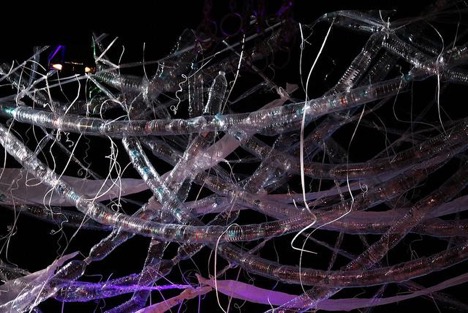
Tree Canopy close up shot
Plastic bottles and packing materials used to represent the forest canopy. Plastic bottles were strung together with high gauge fishing line.

Tree Unit close up
Tree units made out of recycled cardboard, paper bags, and shredded plastic bottles. We found the shredded plastic bottles would sway and move long after being flown in for a particular scene. This would cause the trees to have extra life and movement as the action took place around them.
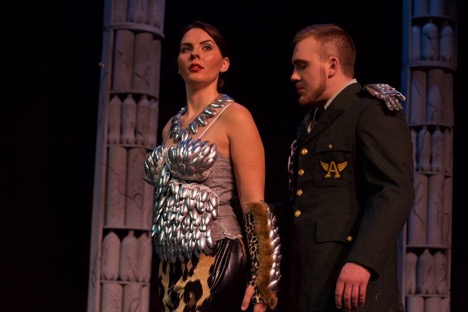
Recycled plastic spoon chest plate and necklace. Costume Design by Jess Larson.
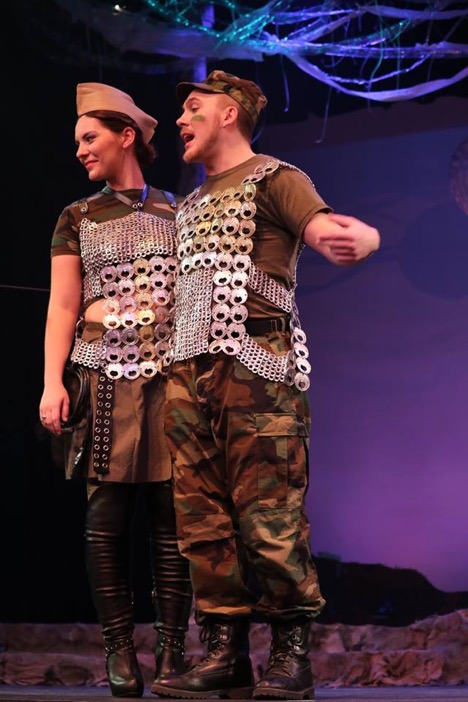
Soup, and soda can armor. Costume Design by Jess Larson.
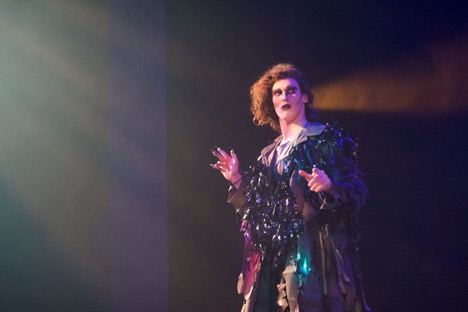
Oberon Trench coat. Recycled Vinyl and VHS tape. Costume Design by Jess Larson.
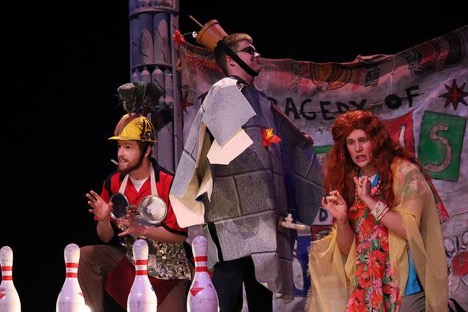
The Tragedy of Pyramus and Thisbe
For the play within the play, we chose to sew together old potato sacks to serve as an acting curtain. A great deal of the props and costumes for this scene were pulled directly from our various shops to add to the haphazard look of the play.
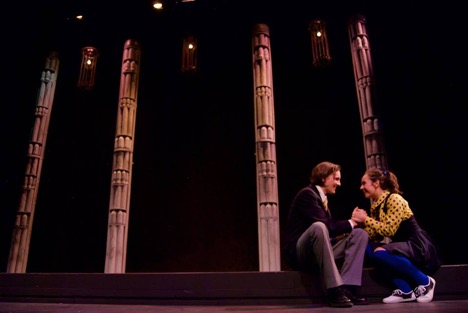
The Court
Columns built out of recycled carpet tubes and soda bottles. Chandeliers built from recycled children's bike parts.
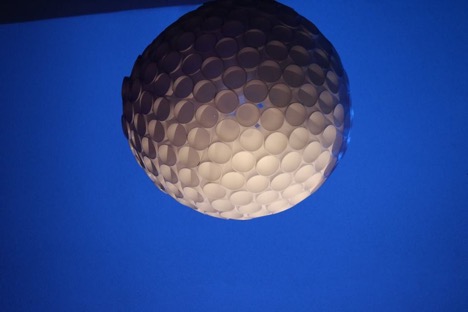
Recycled Coffee cup moon
Close-up of the moon used for this production. This consisted of recycled styrofoam coffee cups hot glued together to create a sphere.
******************************
University of Minnesota Morris
Theatre Discipline’s production of
The Wonderful Wizard of Oz
By
Jacqueline E. Lawton
Director: Ray Schultz
Scenic Design: Lucas Granholm
Lighting Design: Lucas Granholm
Costume Design: Katie Curry
Sound Design: Evan Aanerud and Lucas Granholm
Technical Direction: Benjamin Fink
Puppetry Design: Lucas Granholm and Alyssa Kraft
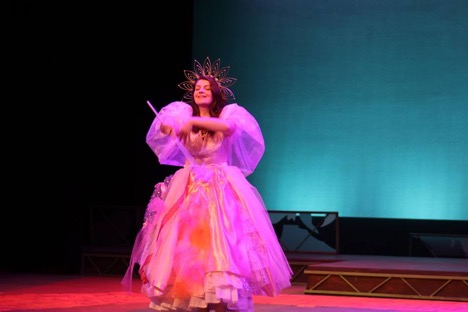
Good Witch, Dress made from recycled packing material, Zip tie crown.
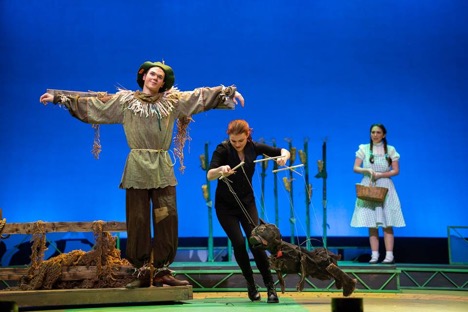
Toto puppet made from recycled basket wicker and burlap. Corn made from recycled PVC tube and soda bottles.
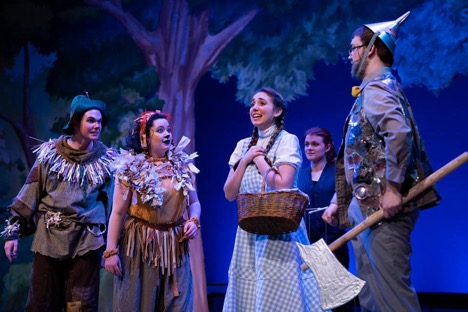
Scarecrow and Lion decorated with recycled paper to add ragged look. Tin man, festooned with recycled soda bottles. [ ]
